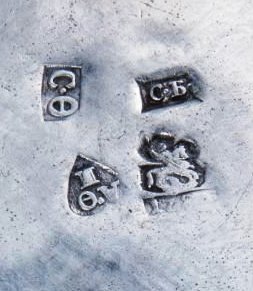Page 1 of 1
Jug & Bowl
Posted: Tue Jan 05, 2021 10:27 am
by juantotree
Hi
I would be most grateful if anybody could help identify these marks found on this silver jug and bowl.
Many Thanks
Martin


Re: Jug & Bowl
Posted: Tue Jan 05, 2021 4:37 pm
by Qrt.S
There must be more marks, kindly look for them and show all marks. Where are this mark on the jug or tray? The marks on the pictures from left
aderman Andrey Kosyrev 1762-1791, the mid mark is Moscow's town St. George mark and the third mark is assayer Andrey Titov 1786-1798. Now you understand why I asked you to find more marks. There is no maker's mark and you must try to find it. If there are no more marks, trouble a sight. An object with only control and town marks but no maker's would indicate import, but I don't think so, find more marks and revert with them.
Re: Jug & Bowl
Posted: Tue Jan 05, 2021 7:01 pm
by AG2012
Hi,
As stated by Qrt.S, full set of marks on a beaker is supposed to look like this for year 1786.

Regards
Re: Jug & Bowl
Posted: Tue Jan 05, 2021 7:34 pm
by juantotree
Hi
Thank you for your responses. The marks shown are on the bowl, the marks to the jug are very worn, but I have uploaded an image of them below.

Re: Jug & Bowl
Posted: Wed Jan 06, 2021 7:16 am
by Qrt.S
I'm afraid that it is not enough. The marks are badly punched and worn. There must be four marks or more on each object. Four marks is enough for the bowl but the jug is made of several parts. Look for additional marks on the jug's handle, foot and spout. Every detachable/soldered part should carry a mark.
Re: Jug & Bowl
Posted: Wed Jan 06, 2021 10:22 am
by AG2012
Hi,
It is supposed to be second half 18th century Russian silver, rather rare to encounter even with modest items like beakers.
Matching jug and basin in pristine condition after 250 years is something very unusual.
Qrt.S mentioned marks on every detachable part before soldering, required by legislation (when? citation needed ) but actually enforced in late 19th century.
The problem is: too many authentic silver items made in early 19th and late 18th century (and let alone earlier silver), have NO marks on every part.
Another disappointing fact are partially struck marks on the rim where very limited space was available, in contrast with enough space elsewhere.
In short, one of the items I cannot judge for sure whether authentic or not.
Regards
Re: Jug & Bowl
Posted: Wed Jan 06, 2021 11:37 am
by Qrt.S
Yes, AG2012 is completely right in saying that the all detachable part must carry marks is stated not earlier than in the assay charter of 1879. I admit that I forgot that, sorry. Anyway, before 1879 it was optional to mark all parts. The idea of marking all parts was based on facts that some wise guys replaced some parts with illegal fineness when returned from the assay office with an assayed object. Around the turn of the century it became again optional to mark all parts or actually the masters didn't care to do it anymore and so the rule became disobeyed.
Re: Jug & Bowl
Posted: Thu Jan 07, 2021 8:42 am
by juantotree
Thanks very much for the information guys, there are no further marks on the jug, if the handle was originally marked it has completely worn away and left no evidence.
Thanks again
Martin
Re: Jug & Bowl
Posted: Thu Jan 07, 2021 10:01 am
by AG2012
Duty dodgers / transposed marks.
Well documented fraudulent British silversmiths who had their light weighted silver items marked after duty was paid, then back in the workshop - marked parts transposed to much heavier items.(The reason for marking hollowware differently from spoons and lacking town marks on British spoons during several decades).
I have observed similar suspicious practice on early 19th century Russian silver, too.
It would be too naïve to assume Russian Empire had better legal system than UK at the time.
The more we know, the more suspicious we get. Alas !
Regards
Re: Jug & Bowl
Posted: Thu Jan 07, 2021 11:31 am
by Juke*
Hi!
In my eyes the style is right, the craftsmanship is right, the marks seem correct and the wear is right for an Russian item from the period so I would vote for authenticity. Probably the makers mark has been polished away. Also it was typical to mark at the rim also in those days to avoid any aesthetic issues so not to let the marks disturb the buyer. It is also good to remember when the marks were issued that there was not a thought that somebody would be interested try to resolve them 250 years later.
Regards,
Juke
Re: Jug & Bowl
Posted: Fri Jan 08, 2021 6:21 am
by Aguest
I was thinking the same thing that the edge-marking was done for aesthetic purposes. ::: If any other edge-marked pieces show up which can be proven to be forgeries, then I stand corrected. ::: And perhaps we could find some edge-marked genuine pieces to compare them with. :::





